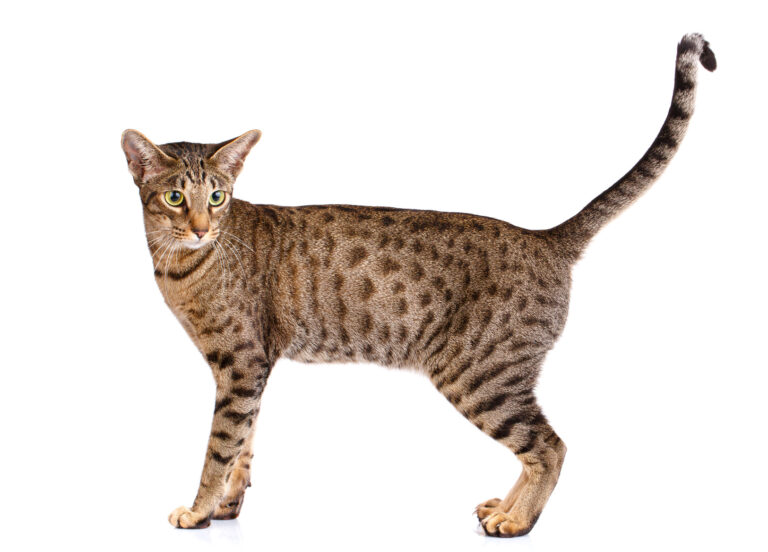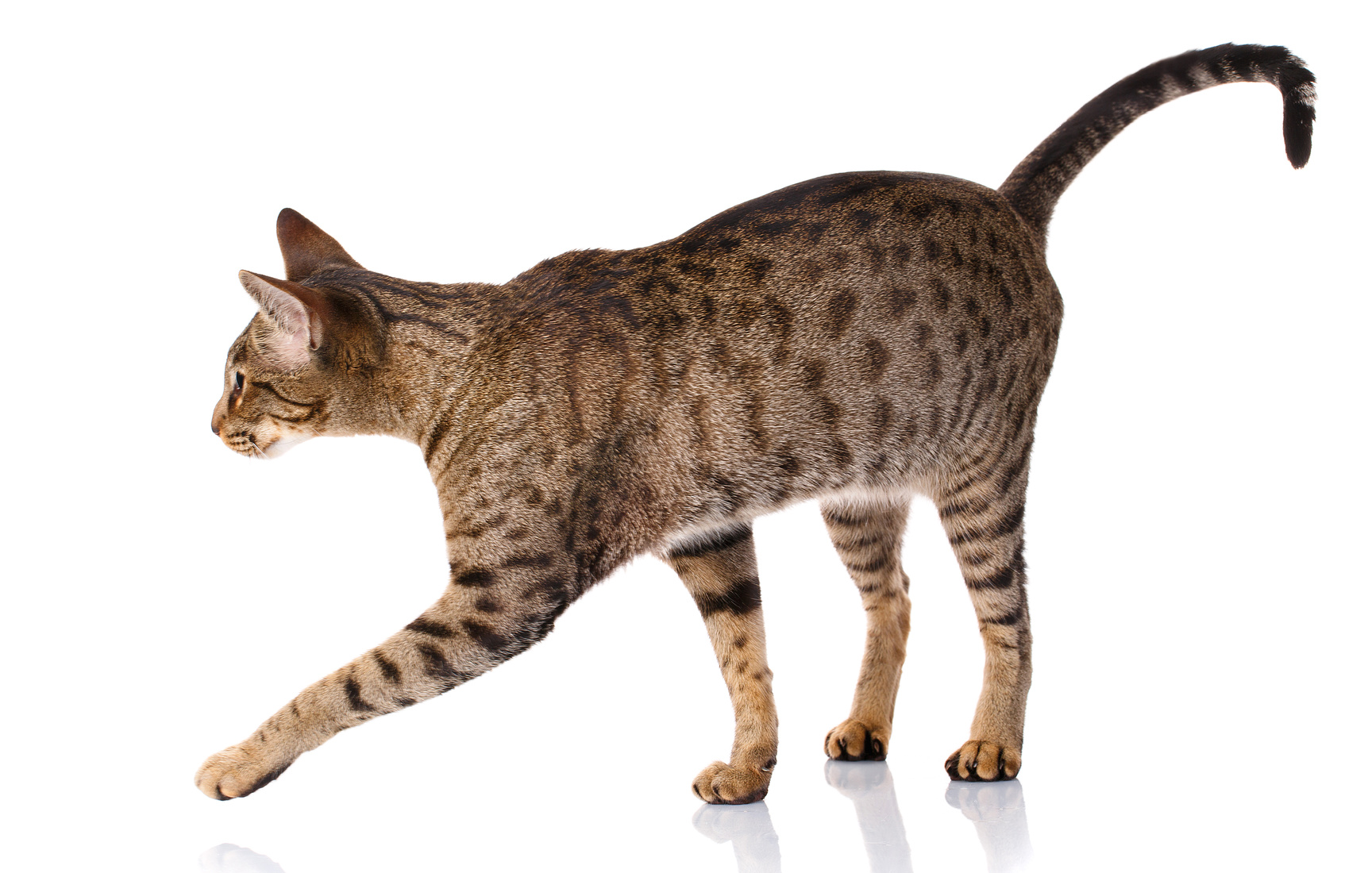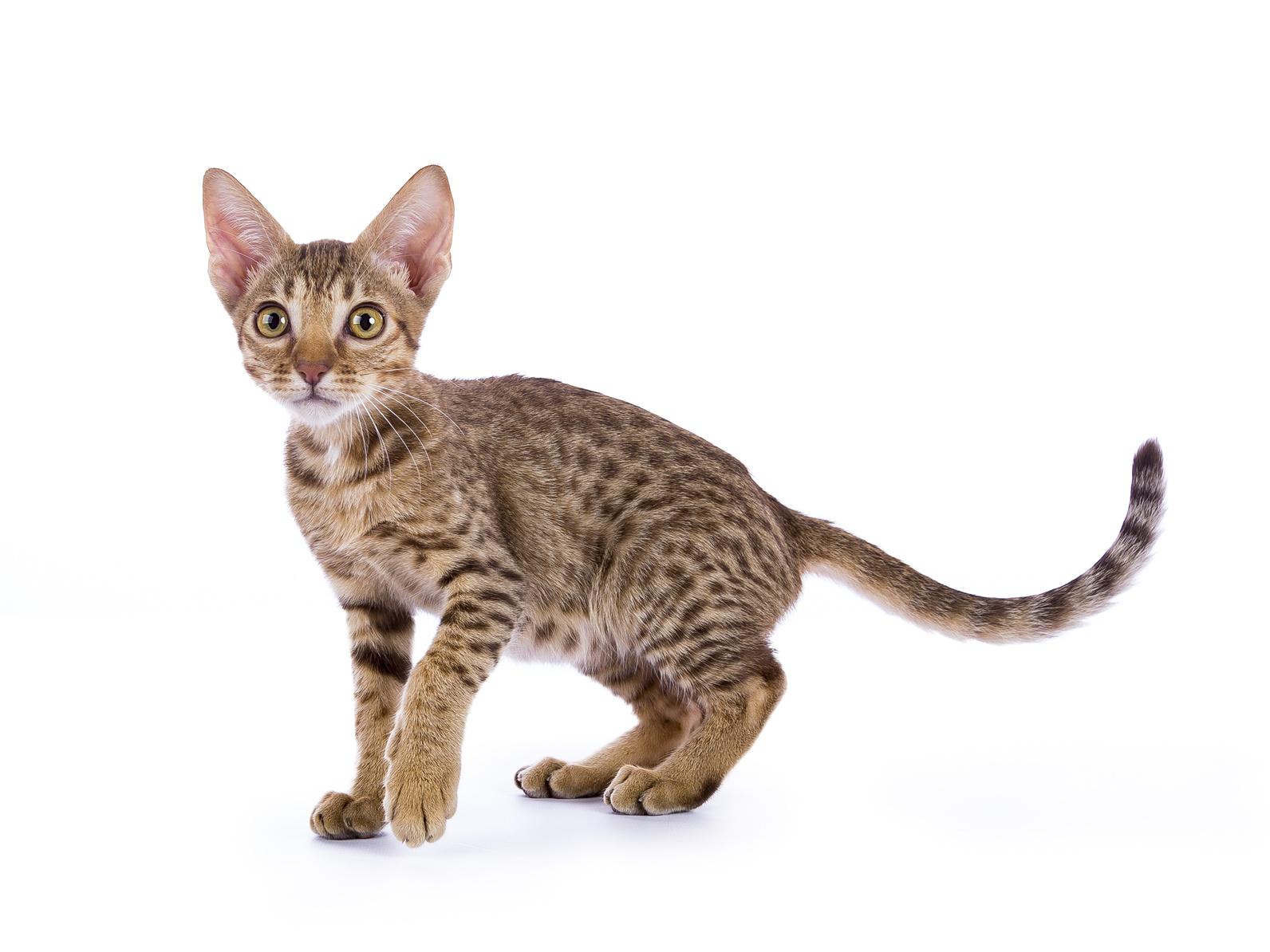Maine Coon
The Maine Coon has now become one of the most popular cat breeds in the world and is enjoying increasing popularity in Ireland, too. This is probably thanks to its authenticity, robustness and excellent character.
With its exotic appearance, the Ocicat casts an immediate and lasting spell over people. Due to its speckled fur, its name is derived from a wildcat called Ozelot. In terms of its nature, however, the Ocicat isn't wild at all, but extremely affectionate and loyal, making it a popular domestic cat.

© serkucher / stock.adobe.com
A woman called Virginia Daly created the Ocicat by chance in 1964 by crossing an Abyssinian cat with a Siamese. Some consider this a failed breeding attempt. However, we find the Ocicat simply remarkable in terms of its nature and appearance and therefore think it is an example of very successful breeding.
The geneticist Dr. Clyde Keeler developed a strong interest in these docile pet cats with a jungle look, therefore breeding of these exotic, affectionate felines continued. In order to increase the variety of colours, the American Shorthair was also paired at a later point.
This is how the Ocicat emerged over the years with its strong physique but graceful appearance. The Ocicat wasn’t recognised as a breed until 1986.
The Ocicat is an athletic cat that combines grace and strength. Females of this breed weigh 4 to 5kg and males up to 7kg. They are supple with their strong legs and are capable of big jumps. Their chest is low and they have slightly curved ribs.
The head is wedge-shaped with well-developed cheekbones and a very pronounced chin. Its ears are medium-sized and always straight to attention. Ocicat eyes are almond-shaped, wide-set and appear friendly. The tail is rather long and tapers off slightly with a dark tip, which is the darkest colour on all the fur. The fur is short, dense and smooth with a silky shine. It is covered with thumbprint-sized markings that contrast to the base colour of the fur.
The Ocicat is found in twelve different colour combinations – six with silver and six without. Spotted Ocicats are found in black, blue, chocolate, lavender, cinnamon and fawn. All colours are also found in the silver variety.
The Ocicat’s face has tabby markings.

For all its wild, exotic looks, the Ocicat is rather tame by nature. It makes a good addition to families and has the reputation of being loyal like a dog. This also means that they are very suitable and popular as domestic cats. The Ocicat also gets on well with small children and dogs, though both should ideally have got used to each other from a young age. Like their wild ancestors, Ocicats enjoy spending time outdoors, where they hunt and go exploring. As a potential owner of this exotic cat breed, you should make sure that your Ocicat gets enough outdoor access in line with species-appropriate housing conditions.
Also be aware that although a cat is on one hand self-sufficient and to this extent “low maintenance”, it is still time-consuming. If you can’t devote the time to your cat that it needs, you should either refrain from buying one entirely or consider taking on a second cat. This means that your beloved feline friends can play together, cuddle and explore the cat-proof garden, even in your absence. Purring and other noises are less pronounced with the Ocicat than with other felines, since the Ocicat doesn’t express pleasure by purring. It will though find other ways of showing happiness.
Ocicats are open and outgoing by nature and are happy to be greeted and stroked even by strangers. Overall, real friendliness defines their character. At the same time, it’s important to the Ocicat to get plenty of attention from its human housemates. In return, the Ocicat pays its human family lots of attention and is very much focused on its loved ones. It really enjoys cuddling with its owner. Some owners of this breed also describe them as confident swimmers that enjoy playing in bathtubs or paddling pools.
In terms of its diet, the Ocicat is straightforward, having the same dietary requirements as other cats. If choosing dry food, make sure it is of a high quality. It must contain all the nutrients, vitamins and minerals that your cat needs for long term good health. With dry food you should also ensure that it has a very low water content (only around 8%). In order to compensate, you should make sure that your cat drinks enough water. You can put out water bowls and set up a drinking fountain for this purpose. Make sure that this is in a different place to the food bowl to represent the cat’s natural feeding conditions.
In the wild, cats consume their water and food in different places, because water could be contaminated by food components, such as a slain mouse. It’s very important for conditions to reflect those in the cat’s natural environment as closely as possible for it live in a species-appropriate manner. With wet food, you need to make sure your cat eats it as soon as possible once you have filled its bowl. If not, it will soon become infested with flies, meaning your cat won’t enjoy it and will most likely leave it.
There are big differences in quality with wet food too. Make sure the nutrients are low in harmful substances and that it contains high-quality proteins that the cat can digest well. Cat food that performs badly in tests often contains an excessively high level of phosphorous, damaging the cat’s kidneys. Price alone isn’t an indicator of good quality. Even amongst very cheap products, there are some that achieve very good results in quality tests.
The feeding option BARF is also worth mentioning. This involves a species-appropriate diet like how cats eat in the wild. Many consider BARF to be the best feeding method for cats. It features raw meat supplemented by vegetables, fodder oils, essential additives and some carbohydrates to guarantee a balanced diet. BARF is therefore closest to the cat’s natural diet, because prey in the wild is also made up of components like lean meat, bones, innards (the liver is particularly valuable), skin and fat, blood, tendons, cartilage, fur, feathers and water. The stomach contents are sometimes included too, which could be made up of grain with a mouse, for instance. In this sense, this feeding method is in line with the natural stipulations of a feline-appropriate diet.
Along with the Ocicat needing an appropriate amount of exercise and outdoor access, it also enjoys further opportunities for activity. Clicker training can be a possibility. You may instead prefer to use cat toys to keep your feline housemate occupied.
The Ocicat likes lively households, as well as contact with many family members, children and other cats, as well as being tolerant of dogs too. It’s important to pay your cat attention – long cuddling sessions are a great way of doing do.
The Ocicat is straightforward when it comes to grooming. It’s enough to occasionally brush its short fur to remove loose hairs.
The Ocicat by nature is of robust health – there aren’t yet any known ailments specific to the breed at least. Like all breeds, it can of course suffer from infections. If you keep in mind ongoing vaccinations, preventive veterinary check-ups and provide a high-quality food, the chances are good that your Ocicat will remain in good health and spirits.
 © Nynke / stock.adobe.com
© Nynke / stock.adobe.com
When choosing a breeder, you should make sure that the adult cats and their kittens live in good, healthy conditions and have a close bond with their human family. This means that the cats are already adapted to conditions similar to those in which they will ultimately live with you. They will also already be used to loud household noises, such as from hoovers and the like, and won’t be confronted with them for the first time at your home.
The fundamental characteristic of a responsible breeder is interest in the living conditions of the cats to be rehomed and wanting to take a look for themselves if possible. Your previous experience is also of interest to the breeder, although this isn’t an obligatory requirement. A good breeder will draw up a purchase contract with you, outlining what to do should the kitten fall ill, amongst other things. A breeder who is genuinely interested in the wellbeing of their cats will be on hand as a point of contact for you after the purchase too.
Membership of a recognised breeding association or pedigree cat club is also an indication of a reputable breeder. The cat’s paperwork should therefore come from a renowned association. In addition, a serious breeder will only breed two different cat breeds at most, since breeding requires very comprehensive knowledge. The cats and the breeder’s premises should obviously be well-kept. The cats shouldn’t come across as too shy either. With all trustworthy breeders, you will also receive a diet plan and they will be a knowledgable point of contact when it comes to nutrition. All male and female cats deployed for breeding should have been vaccinated and have tested negative for leucosis. Not least, your gut instinct is a significant factor when choosing a good breeder.
You’re also better off contacting a reputable interest group of Ocicat breeders and fans – the aim of such groups and associations is to develop as comprehensive a partnership as possible throughout the world for exchanges, providing information and breeding expertise.
Whatever cat you choose, we wish you a wonderful time together.
The Maine Coon has now become one of the most popular cat breeds in the world and is enjoying increasing popularity in Ireland, too. This is probably thanks to its authenticity, robustness and excellent character.
Neva Masquerade – a mysterious name for a mysterious thing of beauty! The Neva Masquerade is the point variation on the Siberian cat and shares many characteristics with this breed.